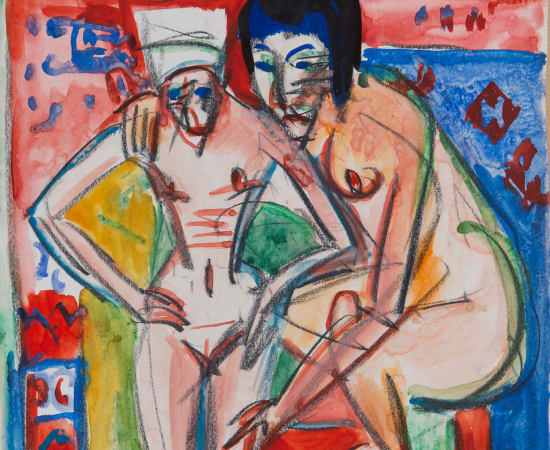Ernst Ludwig Kirchner (1880-1938) German
Works
Biography
A Visionary of Modern Expression
Ernst Ludwig Kirchner stands as a defining force in early 20th-century modernism—a radical innovator whose artistic energy reshaped the visual language of his time. As a founding member of Die Brücke (The Bridge), Kirchner helped usher in German Expressionism with a bold, uncompromising aesthetic that sought to cut through the conventions of bourgeois society and reawaken the raw, emotional core of human experience.
Kirchner’s work pulses with intensity. Angular figures, saturated palettes, and rhythmic compositions mark his urban scenes of Berlin and Dresden, where psychological tension and social dynamism converge on the canvas. Later, his move to the Swiss Alps brought a shift in tone: freer brushwork, more organic forms, and a renewed dialogue with nature—yet always through the lens of a fiercely individual vision.
His art reflects a complex duality: both a critique of modern alienation and a celebration of primal vitality. Influenced by non-Western art, German medieval woodcuts, and the immediacy of the natural world, Kirchner developed a style that was emotionally unfiltered yet structurally rigorous—his work capturing the anxieties and aspirations of a rapidly changing age.
Though his career was cut short by psychological turmoil and political persecution—his work was condemned as “degenerate” by the Nazi regime—Kirchner’s legacy has only grown in stature. Today, his paintings are centerpieces in the collections of the Museum of Modern Art (New York), the National Gallery (Berlin), and the Kunsthaus Zürich, among others.
At Bailly Gallery, Kirchner’s work is recognized not just for its historical significance but for its enduring immediacy. His artistic journey resonates with the gallery’s commitment to bold, uncompromising creativity that transcends era or nationality. Kirchner remains a symbol of modern art’s power to confront, to liberate, and ultimately—to reveal.
Ernst Ludwig Kirchner stands as a defining force in early 20th-century modernism—a radical innovator whose artistic energy reshaped the visual language of his time. As a founding member of Die Brücke (The Bridge), Kirchner helped usher in German Expressionism with a bold, uncompromising aesthetic that sought to cut through the conventions of bourgeois society and reawaken the raw, emotional core of human experience.
Kirchner’s work pulses with intensity. Angular figures, saturated palettes, and rhythmic compositions mark his urban scenes of Berlin and Dresden, where psychological tension and social dynamism converge on the canvas. Later, his move to the Swiss Alps brought a shift in tone: freer brushwork, more organic forms, and a renewed dialogue with nature—yet always through the lens of a fiercely individual vision.
His art reflects a complex duality: both a critique of modern alienation and a celebration of primal vitality. Influenced by non-Western art, German medieval woodcuts, and the immediacy of the natural world, Kirchner developed a style that was emotionally unfiltered yet structurally rigorous—his work capturing the anxieties and aspirations of a rapidly changing age.
Though his career was cut short by psychological turmoil and political persecution—his work was condemned as “degenerate” by the Nazi regime—Kirchner’s legacy has only grown in stature. Today, his paintings are centerpieces in the collections of the Museum of Modern Art (New York), the National Gallery (Berlin), and the Kunsthaus Zürich, among others.
At Bailly Gallery, Kirchner’s work is recognized not just for its historical significance but for its enduring immediacy. His artistic journey resonates with the gallery’s commitment to bold, uncompromising creativity that transcends era or nationality. Kirchner remains a symbol of modern art’s power to confront, to liberate, and ultimately—to reveal.
Enquire

